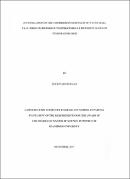Investigation of the compressive strength of ntawo ball clay fired to different temperatures at different rates of temperature rise
Abstract
This study was to investigate the compressive strength of fired Ntawo Ball Clay found in
Mukono District in Central Uganda. The clay sample was first analyzed using X-ray
Diffraction Spectrometer Model RIX3000 to determine the relative abundance of the
chemical components and then compressive strengths were determined.
Ball clay of particle size 45.0 μm was used to produce 150 rectangular clay slabs fired in an
electric furnace, model P59 l 0. They were then subjected to compressive strength test by
first determining the breaking force for each sample using a compressive test machine,
compact 500Sn-12994917 on samples fired at different rates of temperature rise, ranging
between 2°C min- 1 and 6°C min-1 in intervals of 1°C min-1 for set firing temperatures. The
compressive strength tests were then carried out on another set of samples fired at set rates
of temperature rise to different firing temperatures ranging between 500°C and I 000°C in
intervals of I 00°C. The compressive strength of fired tawo ball clay was found to decrease
with increase in rates of temperature rise between 2°Cmin-1 and 6°Cmin-1 for the six firing
temperatures. For temperatures of 500°C to I 000°C in intervals of I 00°C, the percentage
decrease in compressive strength ' ere 11 %, 3%. 3%. 8%, 2.9%, and 11 % respectively. At a
level of significance a = 0.05 and a = 0.0 I, it was established that compressive strength was
related to the rate of temperature rise. The study further revealed that compressive strength
increased with increase in firing temperature. The percentage increase was 279%, 273%,
247%, 257% and 279% for the rates of temperature rise between 2°Cmin-1 and 6°Cmin-1
respectively, overall average percentage increase being 267%. At a level of significance a=
0.05 and a = 0.0 I, compressive strength depended on firing temperature ntawo clay was
found to be composed of mainly silica (67.20%), alumina ( 18.20%), ferrous oxides (2 .83%)
and other fluxing oxides such as CaO (0.31 %). K20 (0.98%), and a20 (0. 19%), among
other compounds. The compressive strength of fired samples decreased with increase in
rates of temperature rise during firing between 500°C and I 000°C. Other investigations
should be made to find out the effect of firing beyond I 000°C and firing at a rate above
6°C min1 on the compressive strength, and the effect of changing the mineralogical
composition of clay on the compressive strength.

